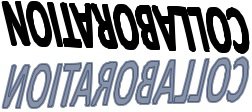 I think I alarmed Judi when she first approached me about joining this blog by saying that I had been wondering lately if we were entering a “post-collaboration” era. I certainly didn’t mean to suggest that the work of co-planning, co-implementing, or co-assessing wasn’t as important, or perhaps even more critical than it ever was. But I have the sense that we are in the midst of a shift from collaboration as a noun that implies a solid state of affairs toward something more fluid – more verb than noun. I found the conversation that took place in the comments last week between Carol and Judi indicative of this state of the matter. As long as we treat collaboration as a solid block, we have to find a space and time where we can meet with our colleagues. Judi’s response about finding time by utilizing Web 2.0 tools such as wikis and Googledocs that allow us to interact asynchronously suggests that school librarians might move more fluidly into those cracks that offer possibilities to work with colleagues when there seemingly is no time in our scheduled days to do so.
I think I alarmed Judi when she first approached me about joining this blog by saying that I had been wondering lately if we were entering a “post-collaboration” era. I certainly didn’t mean to suggest that the work of co-planning, co-implementing, or co-assessing wasn’t as important, or perhaps even more critical than it ever was. But I have the sense that we are in the midst of a shift from collaboration as a noun that implies a solid state of affairs toward something more fluid – more verb than noun. I found the conversation that took place in the comments last week between Carol and Judi indicative of this state of the matter. As long as we treat collaboration as a solid block, we have to find a space and time where we can meet with our colleagues. Judi’s response about finding time by utilizing Web 2.0 tools such as wikis and Googledocs that allow us to interact asynchronously suggests that school librarians might move more fluidly into those cracks that offer possibilities to work with colleagues when there seemingly is no time in our scheduled days to do so.
Collaboration has always been a difficult ideal for the school library profession, and the challenge of finding time has been identified as one of the barriers. Maybe, it’s time we just removed the excuse of time as the barrier that prevents us from making the effort. Taking the lead from the recent talk about flipping classroom instruction, I have been wondering what it would mean to “flip” collaboration. In the mathematics classroom model, flipped instruction means that students get the instructional content on their own time perhaps by watching bite-sized video lectures that introduce the concepts, while class time is used to work through problems that in the past might have been given and graded as homework. Instead students do the work of manipulating and applying content under the guidance of the teacher who is able to coach them through problems. Joyce Valenza provides many examples of flipping instruction and suggests a role for the school librarian in assisting teachers and flipping library lessons in her blog, Neverending Search.
What would it mean to apply that concept to the current model of collaboration where we sit down with teachers before they teach in order to plan instruction together? How could the planning take place asynchronously? The school librarian could have access to what classroom teachers were planning and would be able to post links to resources and lesson ideas. Both the librarian and teacher would have shared calendars so they could schedule lessons with each other. And the actual practicing and application of collaborating might take place in the presence of students. We might all be in the library together; we might all be in a teacher’s classroom together, OR we might use SKYPE, Google Hangout or similar conferencing technology to be together virtually.
And frankly, as I write this I realize that the ideal of collaboration as co-planning, co-teaching, and co-assessing that required us to sit down together to plan often failed to hit the mark on the latter two: co-teaching and co-assessing. What if we flipped this solid-state model of collaboration and exploited the tools that allow us to plan asynchronously and be together virtually during instruction? We might find that the real meaning and value of collaborating are in the performing together as co-teachers and being able to scaffold each other in the work of instruction. We might find that several of those library lessons that we formerly planned collaboratively could become short bite-sized video tutorials for students to visit (and re-visit) as needed. The time we save there could be spent co-coaching with the classroom teacher as students practice and apply what they have learned. And in the work of coaching together, I suspect we would find that conversations about formative assessment would happen more naturally as part of the flow of shared experiences working with students.
I’m going to admit that I am trying to push my own thinking here. I was fortunate as an elementary school librarian to have a flexible schedule with time allotted to plan with teachers. But those blocks of planning time always felt like a luxury, and frankly, I often experienced a conflict because time spent planning was time taken away from working directly with students. While I was working with one grade level, there were many more teachers and students from several other grade levels with whom I was NOT working. And I still hear questions like those from Carol, “but what about those of us who don’t have the time in the schedule for collaboration?” I just have the feeling that we can all find the time to collaborate, even if there isn’t time in our days for collaboration. Several years ago, David Loertscher said it was time for revolution, not evolution in school librarianship and agitated for us to Flip the Paradigm. Loertscher envisioned:
When an assignment is given, everyone—teachers, librarians, students, and other specialists—can comment, coach, suggest, recommend, and discover together, and push everyone toward excellence. (School Library Journal, November, 2008).
I would like to advocate that we look for ways to “flip the paradigm” of collaboration and become more fluid and nimble in our approach to time and how we use it to co-plan, co-implement, and co-assess teaching and learning as we continue to “push everyone toward excellence”.

